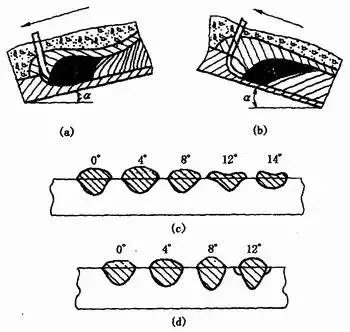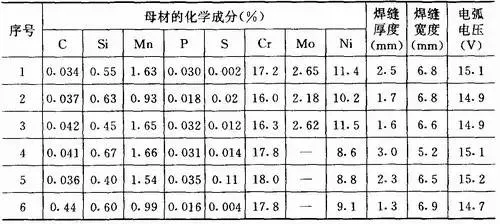Influence of other process parameters and factors on weld shape
(1) Electrode diameter and wire extension When other conditions remain unchanged, reducing the electrode (wire) diameter not only reduces the arc cross-section, but also reduces the arc swing range, so the weld thickness and weld width will be reduced.
Wire extension refers to the length from the contact point between the wire and the conductive nozzle to the end of the wire, that is, the length of the energized part of the wire. When current passes through the wire extension, resistance heat will be generated. Therefore, when the wire extension increases, the resistance heat will also increase, the wire melting will be accelerated, and the excess height will increase. The smaller the wire diameter or the greater the material resistivity, the more obvious this effect is. Practice has shown that for structural steel welding wire, for thick wires with a diameter of more than 5mm, the influence of the wire extension can actually be ignored when it fluctuates within the range of 60 to 150mm. However, when the wire diameter is less than 3mm, when the wire extension fluctuation range exceeds 5 to 10mm, it may have a significant impact on the weld formation. The resistivity of stainless steel welding wire is very large, so this effect is even greater. Therefore, for thin welding wires, especially stainless steel melting electrode arc welding, attention must be paid to controlling the stability of the external elongation.
(2) Electrode (welding wire) tilt When welding, the electrode (welding wire) can be tilted at an angle relative to the welding direction. When the electrode (welding wire) tilts along the welding direction, it is called backward tilt; when it is against the welding direction, it is called forward tilt, see Figure 1-(a) (b). When the electrode (welding wire) tilts forward, the arc force on the rear discharge of the liquid metal in the molten pool is weakened, and the liquid metal at the bottom of the molten pool thickens, which hinders the arc from heating the base material at the bottom of the molten pool, so the weld thickness is reduced. At the same time, the arc strengthens the preheating effect of the unmelted base material in the front of the molten pool, so the weld width increases, the excess height decreases, and the forward tilt angle. The smaller the smaller, the more obvious this effect is, see Figure 1-(c).

Figure 1 Effect of electrode (wire) inclination angle on weld shape
(a) Rearward tilt (b) Forward tilt (c) Effect of forward tilt angle
When the electrode (welding wire) tilts backward, the situation is the opposite of the above.
(3) Welding piece tilt When the weldment is tilted relative to the horizontal plane, the shape of the weld can be significantly different due to different welding directions. After the weldment is tilted, the welding method can be divided into two types: welding from high to low is called downhill welding; welding from low to high is called uphill welding, see Figure 2-(a)(b).

Figure 2 Effect of weldment inclination on weld shape
(a) Downslope welding (b) Upslope welding (c) Influence of the inclination angle of the weldment during downslope welding (d) Influence of the inclination angle of the weldment during upslope welding
When uphill welding is performed, the liquid metal in the molten pool flows to the tail of the molten pool under the action of gravity and arc force, and the arc can penetrate into the metal at the bottom of the heated molten pool, thereby increasing the weld thickness and excess height. At the same time, the heating effect of the front of the molten pool is weakened, the arc swing range is reduced, and the weld width is reduced. The larger the uphill angle, the more obvious the effect. Uphill angle. When >6°~12°, the weld will be too high due to excessive excess height, and undercuts will appear on both sides, which will deteriorate the forming, see Figure 2-(d). Therefore, in automatic arc welding, uphill welding is actually always avoided as much as possible.
The situation of downhill welding is just the opposite, that is, the weld thickness and excess height are slightly reduced, while the weld width is slightly increased. Therefore, the inclination angle. Downslope welding with an angle of <6°~8° can improve the surface weld formation. When welding thin plates with manual arc welding, downslope welding is often used. On the one hand, it can avoid burn-through of the weldment, and on the other hand, it can obtain a smooth weld surface formation. If the inclination angle is too large, it will lead to incomplete penetration and overflow of molten iron in the molten pool, which will deteriorate the weld formation, as shown in Figure 2-(c).
(4) Groove shape When other conditions remain unchanged, when the groove depth and width are increased, the weld thickness increases slightly, the weld width increases slightly, and the excess height decreases significantly, as shown in Figure 3.

Figure 3 The influence of groove shape on weld shape
(5) Flux During submerged arc welding, the composition, density, particle size and stacking height of the flux have a certain influence on the weld shape. When other conditions are the same, the weld thickness of the flux with poor arc stability is larger and the weld width is smaller. When the flux density is small, the particle size is large or the stacking height is reduced, the pressure around the arc is reduced, the arc column volume expands, and the arc swing range is expanded, so the weld thickness decreases, the weld width increases, and the excess height decreases slightly. In addition, the viscosity of the slag has a great influence on the surface formation of the weld. If the viscosity is too high, the permeability of the slag will be poor, and the gas discharged during the crystallization of the molten pool cannot be discharged through the slag, resulting in many pits on the surface of the weld and deteriorating the formation.
(6) Shielding gas composition In gas shielded welding, the composition of the shielding gas and the closely related droplet transfer form have a significant effect on the weld shape. When different shielding gases are used for DC reverse connection of metal-metal gas shielded welding, the changes in weld shape are shown in Figure 4. Jet transition argon arc welding always forms a clear mushroom-shaped weld. When O2, CO2 or H2 is added to the argon gas, the root formation can be widened and the weld thickness can be slightly increased. Granular and short-circuit transition arc welding forms a wide and shallow weld.

Figure 4 Effect of shielding gas composition on weld shape
(7) Chemical composition of the base material The chemical composition of the base material is different. When other process factors remain unchanged, the weld shape is different. This is particularly obvious in argon arc welding. For example, when three stainless steels of different origins, 0Cr18Ni19 and 0Cr18Ni12Mo2, are welded by tungsten inert gas welding with the same welding process parameters, the changes in the weld shapes are shown in Table 5.
Table 5 Effect of base metal chemical composition on weld shape

Note: Tungsten rod end 45°; arc length 2mm; current 150A; welding speed 300mm/min.
-
What is a medium-frequency pulse? What types of welding are suitable for?BalitaNov.24,2025
-
Why is the overall cost of CO2 welding lower than that of shielded metal arc welding?BalitaNov.21,2025
-
Welding Knowledge 6BalitaNov.20,2025
-
What is a low-frequency pulse? What types of welding are they suitable for?BalitaNov.19,2025
-
Why are the weld joints from CO₂ gas shielded welding of such high quality?BalitaNov.18,2025
-
J506 Welding Rod - Low Hydrogen, All-Position, AC/DC E7016BalitaNov.17,2025


